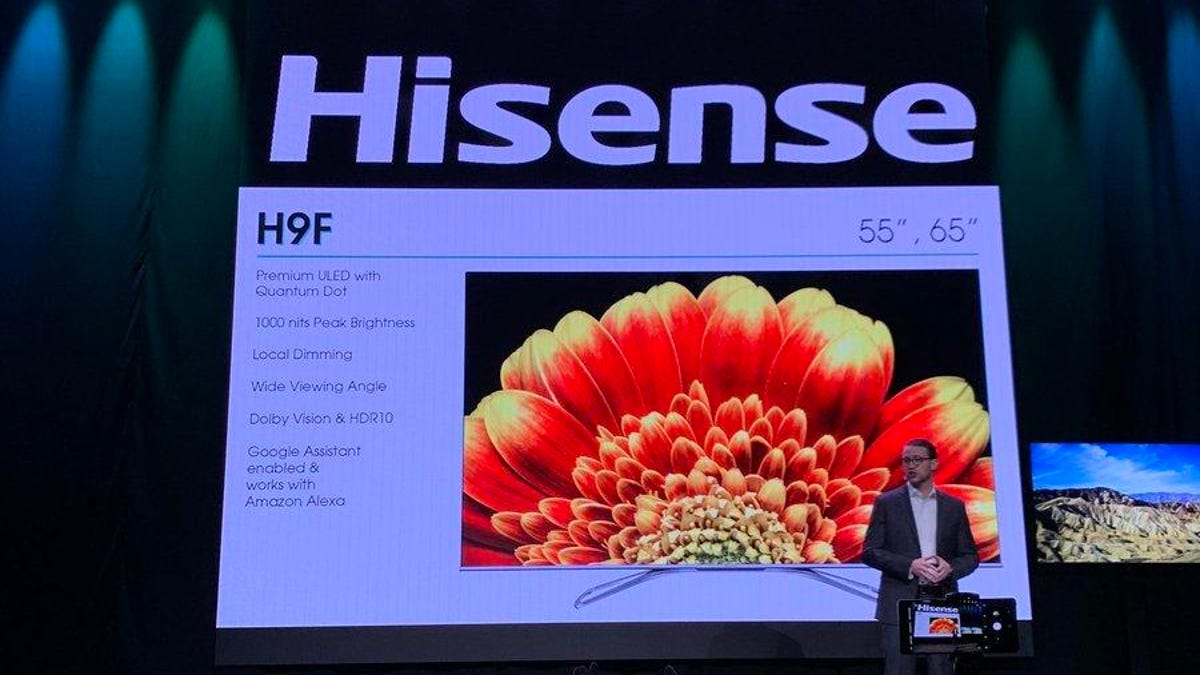Everything Hisense just announced at CES 2019
Roku TVs, local dimming LCDs and smart systems are what we're seeing from Hisense in 2019.

The Hisense H9F includes Premium ULED quantum dot technology with anti glare reflection and 1000 nits brightness.
Hisense , one of the TV brands in domestic China, is a less-familiar name to Americans than even TCL, a fellow Chinese brand that has become increasingly successful in the US.
For its 2019 lineup, Hisense is taking a page from TCL by improving the picture quality of some of the most popular kinds of TVs: those that use Roku's operating system. It also introduced a new all-in-one laser "TV" (er, projector) and a few other bits of intriguing TV tech. Here's the rundown.
R8 series Roku TV: On paper this set looks like a serious rival to TCL's 6 series, CNET's favorite TV for the money, which combines Roku's superb smart TV system with the picture quality chops of full-array local dimming. The R8 has a healthy 64 zones of dimming on the 65-inch size, wide color gamut, 700 nits of brightness and Dolby Vision, all for less than the TCL 6 series. Shipping "later in 2019" the 55-inch size costs $600 and the 65 an aggressive $750.
The Hisense R8.
H8F series Android TV : This set offers all of the picture quality features of the R8 but with Google Android TV smart system instead of Roku's. Google Assistant voice control is built-in and the set also works with Amazon Alexa. It will launch in May 2019 starting at $400 for the 50-inch and up to $750 for the 65-inch.
H9F and U9F series Android TVs: These step-up models offer improved image quality specs, thanks to quantum dot technology. The H9F (May, $700 for 55-inch and $1,000 for the 65-inch) has 150 dimming zones and gets up to 1,000 nits in brightness, while the U9F (June, available only in a 75-inch size for $3,500) has a whopping 1,000+ zones and 2,200 nits of peak brightness.
The 75-inch Hisense U9 claims more than 1,000 dimming zones.
100- and 120-inch 4K laser short-throw projector systems: Hisense bests on previous gigantic "TVs" -- actually projection systems that consist of the screen, a projector that can sit very close to the wall, and a sound system -- by adding a new dual-color laser light engine for improved color. The screens are designed to work well in bright lighting and the sound system is built into the projector, augmented by a wireless subwoofer. Alexa support is built in, available via the voice remote. Pricing was not announced, but for reference the 2018 100-inch setup was $10,000.
Beyond those shipping products Hisense also talked up some of its more future-looking tech.
The backside of the Hisense One, said to be the thinnest 65-inch TV in the industry.
ULED XD: Hisense likes to call its high-end sets "ULED" (don't ask me what it stands for) so this variation is called "Extreme Detail." It's an all-new LCD panel design that "layers a 1080p module displaying a grayscale image between a full array LED backlight and a 4K module displaying a full color image." Hisense claims improved dynamic range, brightness (2,900 nits), and "unsurpassed" black levels. I'm intrigued to check it out in person.
4K RGB laser TV: An improvement on its laser projection tech that uses three separate lasers, one each for red, green and blue. The result, according to Hisense, should eventually achieve 100 percet of the Rec 2020 wide color gamut.
Hisense One Design: Billed as the "thinnest-self contained 65-inch television in the industry," the set ranges from less than 1/4-inch at its thinnest to 1 inch at its thickest point. And the screen itself acts like a speaker, similar to some OLED TVs.

